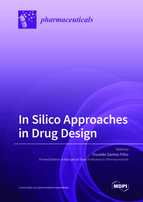In Silico Approaches in Drug Design
A special issue of Pharmaceuticals (ISSN 1424-8247). This special issue belongs to the section "Medicinal Chemistry".
Deadline for manuscript submissions: closed (30 April 2022) | Viewed by 140774
Special Issue Editor
Interests: molecular modeling; computational and medicinal chemistry; molecular simulations; structural biology
Special Issues, Collections and Topics in MDPI journals
Special Issue Information
Dear Colleagues,
In the last few decades, computational methods have been successfully applied by the pharmaceutical community. This is mainly due to the development of both new theoretical approaches and new hardware and software technologies. In this context, in silico approaches such as molecular simulations, QM/MM simulations, chemoinformatics, artificial intelligence, etc., became fundamental in the drug design process. It can even be said that today it is impossible for a new drug to be invented without going through the “sieve” of in silico research. To celebrate the success story and advances in the important synergistic combination of drug design and in silico investigation, the journal Pharmaceuticals invites fellow scientists to submit original papers or reviews, which will be published in a Special Issue on “In silico Approaches in Drug Design 2021”. Such an issue will contemplate the following topics: computer-aided drug design, molecular dynamics simulations, Monte Carlo simulations, QM/MM simulations, molecular docking, chemoinformatics, in silico databases, data mining, machine learning, pharmacophore-based virtual screening, combinatorial chemistry, QSAR, and in silico ADMET.
Looking forward to your contribution.
Prof. Dr. Osvaldo Andrade Santos-FilhoGuest Editor
Manuscript Submission Information
Manuscripts should be submitted online at www.mdpi.com by registering and logging in to this website. Once you are registered, click here to go to the submission form. Manuscripts can be submitted until the deadline. All submissions that pass pre-check are peer-reviewed. Accepted papers will be published continuously in the journal (as soon as accepted) and will be listed together on the special issue website. Research articles, review articles as well as short communications are invited. For planned papers, a title and short abstract (about 100 words) can be sent to the Editorial Office for announcement on this website.
Submitted manuscripts should not have been published previously, nor be under consideration for publication elsewhere (except conference proceedings papers). All manuscripts are thoroughly refereed through a single-blind peer-review process. A guide for authors and other relevant information for submission of manuscripts is available on the Instructions for Authors page. Pharmaceuticals is an international peer-reviewed open access monthly journal published by MDPI.
Please visit the Instructions for Authors page before submitting a manuscript. The Article Processing Charge (APC) for publication in this open access journal is 2900 CHF (Swiss Francs). Submitted papers should be well formatted and use good English. Authors may use MDPI's English editing service prior to publication or during author revisions.
Keywords
- Computer-aided drug design
- Molecular dynamics simulations
- Monte Carlo simulations
- QM/MM simulations
- Molecular docking
- Chemoinformatics
- In silico database
- Data mining
- Machine learning
- Pharmacophore-based virtual screening
- Combinatorial chemistry
- QSAR
- In silico ADMET







